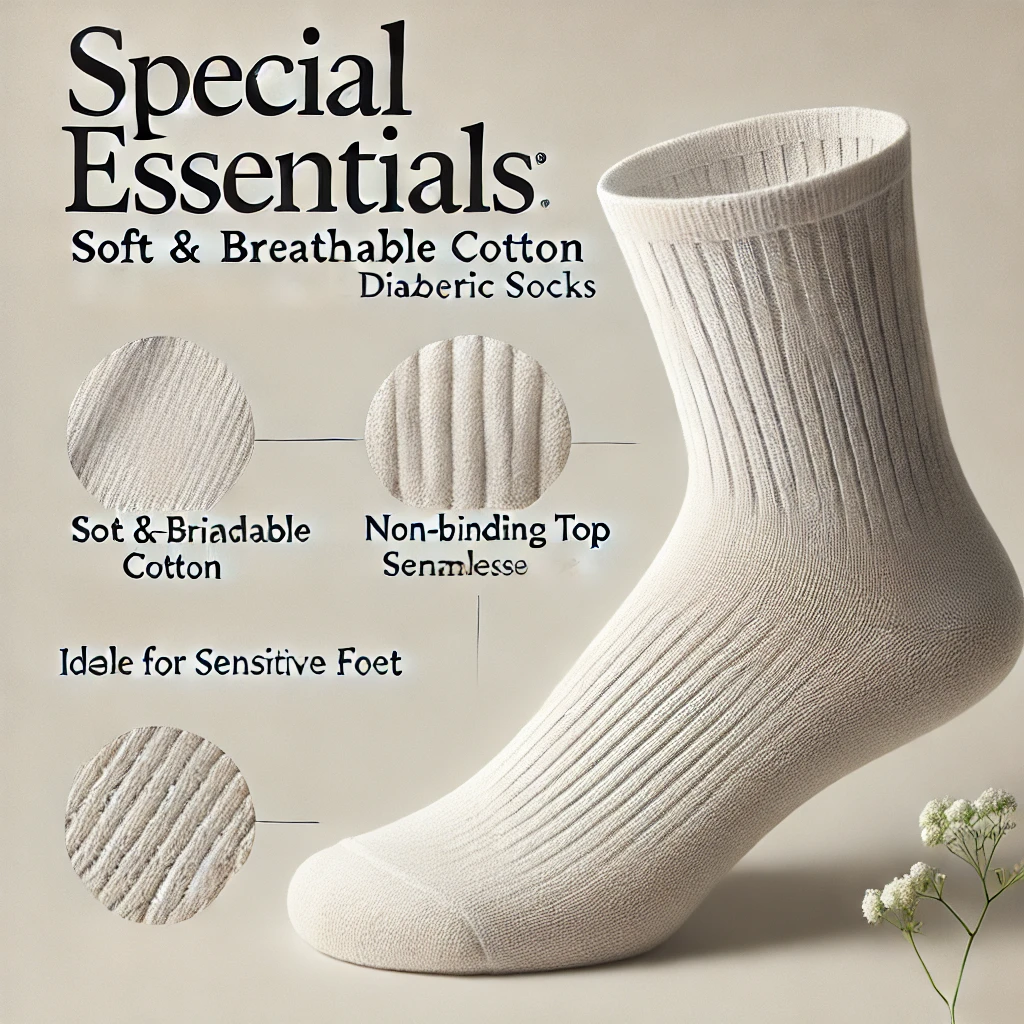Diabetic Foot Care : For individuals living with diabetes, understanding the importance of a Low-Sugar Diet and Foot Protection for Diabetics is crucial. Elevated blood sugar levels can lead to severe complications, particularly concerning foot health. Consequently, embracing a healthy lifestyle rooted in dietary choices becomes a vital strategy in preventing and managing diabetic foot issues. This article explores the relationship between diabetes, foot care, and dietary practices, providing essential insights into low-sugar diets and delicious recipes that can foster optimal foot health.
Contents
Understanding the Link Between Low Sugar Diets and Diabetic Foot Health

The interplay between a low-sugar diet and diabetic foot health is complex yet critical. When blood glucose levels remain elevated, they can wreak havoc on the body’s systems, especially those governing foot health. Therefore, grasping this connection is the first step toward better self-management for diabetics.
The Role of Blood Sugar Control
Maintaining stable blood sugar levels is paramount for overall health in individuals with diabetes. Frequent spikes in blood glucose can result in damaging effects over time. High sugar consumption leads to glycation, where glucose binds to proteins and fats, causing inflammation and cellular damage. Notably, blood vessels and nerves suffer significantly from these fluctuations.
In trying to protect one’s feet from potential complications, adhering to a low-sugar diet helps to stabilize blood glucose levels. As the body adapts to healthier food choices, it becomes increasingly easier to maintain consistent energy levels while reducing the risks associated with poor circulation and neuropathy.
Implications for Peripheral Health
One of the most significant concerns for diabetics is the condition known as peripheral artery disease (PAD). This condition arises when high blood sugar damages blood vessels, leading to narrowed arteries and reduced blood flow to the extremities. With limited circulation, the risk of developing ulcers or infections increases substantially.
Adopting a low-sugar diet aids in supporting vascular health by reducing inflammation and improving blood flow. Such positive changes in the body increase the chances of avoiding serious foot complications like gangrene or amputation.
Preventing Complications Through Nutrition
Incorporating a variety of nutrient-rich foods into meals—such as lean proteins, whole grains, fresh vegetables, and healthy fats—contributes to improved foot health. A well-rounded diet minimizes reliance on sugary snacks, subsequently reducing the risks of nerve damage and foot-related complications.
Realizing the profound impact of nutrition on foot health presents a compelling argument for diabetes management—a reminder of how dietary changes can ultimately shape one’s quality of life.
The Impact of High Blood Sugar on Foot Circulation and Nerve Function

High blood sugar does not exist in isolation; its ramifications extend throughout the body, particularly affecting circulation and nerve function. Understanding these impacts allows individuals with diabetes to take proactive steps in preserving their foot health.
Impaired Blood Circulation
Blood circulation plays a pivotal role in maintaining the health of every cell in the body, including those in the feet. When blood sugar levels are consistently high, the lining of blood vessels can become damaged, resulting in atherosclerosis. This narrowing of arteries limits oxygen delivery to the tissues, which can lead to significant problems—for instance, slow healing wounds, infections, or even tissue death.
Moreover, poor circulation can cause symptoms such as pain, numbness, or cold sensations in the feet. By adopting a low-sugar diet, individuals can help mitigate some of these effects. Reduced sugar intake lowers inflammation within the body, potentially reversing some of the damage caused by years of poor blood sugar management.
Nerve Damage (Diabetic Neuropathy)
Chronic high blood sugar wreaks havoc on the nervous system, leading to a condition known as diabetic neuropathy. This complication results from direct damage to nerve fibers, resulting in sensory loss or discomfort. Individuals may experience tingling, burning sensations, or complete loss of feeling in their feet, making it difficult to detect injuries or infections.
Implementing a low-sugar diet can have a protective effect on nerve health. Lower glucose levels can aid in restoring some nerve function and sensitivity, promoting better awareness of one’s body. This awareness is vital, as early detection of foot injuries can prevent the escalation of more significant complications.
The Risk of Infection and Slow Healing
With compromised blood flow and nerve damage, the body becomes increasingly susceptible to infections. Minor cuts or blisters can escalate quickly into severe conditions requiring extensive treatment, such as amputations. Additionally, high blood sugar hinders the natural healing process, prolonging recovery times.
By adopting a low-sugar lifestyle, individuals can enhance their immune response and improve wound-healing capabilities. Focusing on nutrient-dense foods provides the vitamins and minerals necessary for maintaining robust health and accelerating recovery.
Understanding these intricate links reinforces the need for individuals with diabetes to prioritize dietary choices, with a specific emphasis on limiting sugar intake to promote better foot health.
Essential Dietary Guidelines for Diabetics: Managing Blood Sugar and Promoting Foot Health

Navigating dietary choices can often feel overwhelming, especially for those managing diabetes. However, following foundational guidelines can simplify meal planning and contribute positively to foot health.
Limit Sugar Intake
A primary principle in managing diabetes revolves around minimizing sugar intake. Avoiding added sugars—such as those found in sodas, sweets, and processed foods—is essential. Instead, individuals should focus on utilizing naturally sweet options like fruits, which provide essential nutrients alongside their natural sugars.
Being vigilant about reading food labels is another crucial aspect of maintaining a low-sugar diet. Many packaged foods contain hidden sugars, so familiarizing oneself with ingredient lists can avert unintentional overconsumption.
Prioritize Complex Carbohydrates
Complex carbohydrates are a cornerstone of a balanced diet for diabetics. Whole grains, legumes, and starchy vegetables offer substantial fiber content, which slows down the absorption of glucose into the bloodstream. This gradual release prevents sudden spikes in blood sugar levels, promoting better overall control.
Incorporating plenty of non-starchy vegetables into daily meals is equally important. These low-carbohydrate options are rich in fiber while being nutrient-dense, ensuring that blood sugar remains stable without sacrificing essential vitamins and minerals.
Incorporate Lean Protein Sources
Protein is an indispensable part of anyone’s diet, but especially for those managing diabetes. Lean protein sources—such as fish, chicken, turkey, and plant-based options like beans and lentils—support muscle maintenance and satiety without contributing excess sugar or saturated fat.
Reducing the intake of red meat or processed meats is advisable, as these can pose risks to heart health, which directly correlates to foot health. Prioritizing heart-healthy protein choices further fortifies against complications arising from diabetes.
Increase Dietary Fiber
Fiber plays a crucial role in stabilizing blood sugar levels. It regulates digestion and enhances feelings of fullness, making it a valuable ally in managing weight and cravings. Incorporating fiber-rich foods like whole grains, fruits, vegetables, and legumes into meals can help control blood sugar levels effectively.
A gradual approach to increasing fiber intake is essential to avoid gastrointestinal discomfort. Patients should monitor their bodies’ responses and adjust accordingly, aiming to meet their individual needs while prioritizing digestive health.
These dietary guidelines aim to provide a comprehensive roadmap for individuals living with diabetes. Each choice made has implications for managing blood sugar levels and preserving foot health, underscoring the significance of mindful eating.
Low Sugar Diet Recipes and Meal Planning for Diabetic Foot Care

Creating a low-sugar meal plan does not equate to sacrificing flavor or satisfaction. A multitude of delicious and nutritious recipes can be tailored to fit the dietary needs of those managing diabetes, promoting foot health while tantalizing the taste buds.
Breakfast Ideas
Morning meals set the tone for the day, making them a perfect opportunity to fuel the body with nutritious choices.
Overnight Oats with Chia Seeds
Combining rolled oats with unsweetened almond milk, chia seeds, and a handful of berries creates a filling breakfast rich in fiber and healthy omega-3 fatty acids. This nutritious option helps regulate blood sugar levels while keeping you satiated throughout the morning.
TRUEplus® Glucose Tablets, Raspberry Flavor – 50ct
Scrambled Eggs with Spinach and Tomatoes
A protein-packed breakfast option combining scrambled eggs with seasonal vegetables offers a satisfying start to the day. Providing essential vitamins and minerals, this dish supports overall health while ensuring sustained energy levels without spiking glucose.
Lunch Options
Lunch can be enjoyable and nourishing, with many low-sugar options available.
Quinoa Salad with Grilled Chicken and Vegetables
This vibrant salad mixes cooked quinoa with grilled chicken, bell peppers, cucumbers, and a sprinkle of feta cheese. The combination of lean protein and fiber-rich quinoa keeps hunger at bay while promoting steady blood sugar levels.
Vegetable Soup with Beans
A hearty vegetable soup featuring a variety of colorful veggies and beans provides both warmth and comfort. Rich in fiber and nutrients, this dish helps to stave off cravings while supporting optimal blood sugar control.
Dinner Delights
Dinner meals should satisfy and nourish, ensuring a wholesome end to the day.
Baked Salmon with Asparagus
Rich in omega-3 fatty acids, salmon is a heart-healthy choice paired with roasted asparagus drizzled with olive oil. This simple yet elegant meal promotes cardiovascular health while offering an array of flavors.
Zucchini Noodles with Turkey Meatballs
Replacing traditional pasta with zucchini noodles creates a lighter dish that’s still filling. Paired with homemade turkey meatballs and a savory marinara sauce, this recipe delivers lean protein and essential nutrients without the excess carbohydrates.
Snack Time Treats
Healthy snacking keeps energy levels up and assists in managing blood sugar.
Apple Slices with Almond Butter
Nutritious apple slices paired with almond butter create a delightful snack bursting with fiber and healthy fats. This combination helps maintain stable blood sugar levels while providing a fulfilling option.
Greek Yogurt with Berries
Packed with probiotics and protein, Greek yogurt served with fresh berries serves as a refreshing snack. This low-sugar option nourishes the gut while curbing sweet cravings.
Effective meal planning is vital for success in implementing a low-sugar diet. Preparing meals in advance ensures access to nutritious options, reducing the temptation to indulge in unhealthy alternatives.
Recognizing and Preventing Diabetic Foot Complications with a Low Sugar Lifestyle
Awareness of warning signs associated with diabetic foot complications can empower individuals to take charge of their health proactively. A low-sugar lifestyle plays a significant role in mitigating risks and enhancing overall wellness.
Recognizing Warning Signs
Being cognizant of changes in one’s feet is crucial for early intervention and prevention of complications.
Changes in Sensation
Individuals should note any unusual sensations, such as tingling or numbness. These might indicate nerve damage, necessitating prompt medical evaluation. Early recognition can make a difference in the course of treatment and recovery.
Skin Color Changes
Observing any alterations in skin color—such as redness, warmth, or discoloration—can signal underlying issues. Swelling in the feet or ankles may also suggest circulatory problems, which require attention to prevent progression to serious conditions.
Proactive Prevention Strategies
In conjunction with a low-sugar diet, proactive strategies can diminish the likelihood of developing foot complications.
Regular Foot Inspections
Performing regular checks for cuts, blisters, or signs of infection is essential. Early detection can facilitate timely interventions, making the difference between minor and major issues.
Proper Foot Hygiene
Maintaining proper foot hygiene includes washing the feet daily, drying thoroughly, and moisturizing (avoiding areas between the toes). This routine keeps the skin intact and prevents fungal infections.
Professional Assistance
Enlisting the expertise of healthcare professionals is vital in managing diabetic foot health. Regular check-ups with podiatrists can ensure early detection of potential complications. Additionally, collaborating with registered dietitians can optimize nutritional choices, reinforcing the importance of a low-sugar lifestyle.
Recognizing warning signs and maintaining preventative practices forms a robust defense against diabetic foot complications. Armed with knowledge and a commitment to dietary change, individuals can enhance their quality of life significantly.
Foot Care Best Practices for Diabetics Following a Low Sugar Diet
Beyond dietary habits, implementing effective foot care practices is indispensable for individuals with diabetes. Proper self-care routines can significantly reduce the risk of complications while promoting overall foot health.
Daily Foot Inspections
Conducting daily foot inspections is a simple yet powerful practice for monitoring foot health. Individuals should examine their feet closely, looking for any cuts, blisters, redness, or swelling.
Encouraging habit formation involves setting aside a few minutes each day dedicated solely to foot care. By incorporating this practice into their routine, individuals are less likely to overlook potential issues that could escalate into serious complications.
Maintaining Healthy Footwear
Choosing appropriate footwear is essential for preventing injuries and promoting foot comfort. Well-fitting shoes with ample space for toe movement are vital in avoiding blisters or calluses.
Opting for cushioning insoles can provide extra support and comfort, reducing strain during daily activities. Additionally, wearing moisture-wicking socks can help keep feet dry, lessening the likelihood of fungal infections.
Moisturizing and Protecting Feet
Keeping the feet moisturized is crucial for maintaining skin integrity. Dry, cracked skin is prone to infections, so applying moisturizer (avoiding spaces between the toes) contributes to healthy foot conditions.
For individuals who spend extended periods on their feet, wearing protective pads or orthotic devices can alleviate pressure. These measures serve as preventive tactics to ward off injury and discomfort.
Foot care best practices complement a low-sugar diet, creating a holistic approach to diabetic foot health. By implementing consistent routines, individuals can preserve their foot health and enhance their overall quality of life.
Maintaining Healthy Feet with Regular Exercise and Supportive Footwear
Physical activity and the right footwear play integral roles in maintaining healthy feet for individuals with diabetes. Striking a balance between exercise and supportive footwear can yield tremendous benefits.
Importance of Regular Exercise
Engaging in regular physical activity brings numerous advantages for individuals managing diabetes. Exercise promotes blood circulation, enhances mood, and contributes to weight management, all of which positively impact foot health.
Activities such as walking, swimming, and cycling can be excellent options for improving cardiovascular fitness. Before commencing any new exercise program, individuals should consult their healthcare provider to ensure safety and suitability.
Choosing the Right Footwear
Selecting appropriate footwear is crucial for preventing injuries and ensuring comfort during physical activity. Shoes should provide adequate arch support and cushioning to absorb shock during movement.
Individuals should also seek out shoes specifically designed for individuals with diabetes. These shoes often feature additional space, breathable materials, and removable insoles for personalized adjustments.
Stretching and Strengthening Exercises
Incorporating stretching and strengthening exercises into daily routines can significantly enhance foot health. Simple stretching movements targeting the calf muscles can improve flexibility while reducing stiffness.
Strengthening the muscles in the feet and legs through targeted exercises can enhance stability and prevent imbalance. These practices contribute to overall mobility, reducing the risk of falls and injuries.
Engagement in regular exercise, coupled with the right footwear, lays the foundation for healthy feet. Such approaches empower individuals with diabetes to take proactive steps in safeguarding their foot health.
The Role of Podiatrists and Healthcare Professionals in Diabetic Foot Management
Collaboration with healthcare professionals, such as podiatrists and registered dietitians, is essential for optimal diabetic foot management. Their expertise can make a significant impact on foot health outcomes.
Regular Check-Ups
Routine check-ups with podiatrists allow for professional assessments of foot health. Podiatrists specialize in diagnosing and treating foot-related issues, making them invaluable resources for individuals with diabetes.
During these visits, podiatrists can identify potential complications early, providing guidance on preventive measures and treatment options. Engaging in regular appointments fosters a proactive approach to foot care, allowing patients to remain informed about their health.
Personalized Dietary Guidance
Registered dietitians can offer tailored dietary recommendations based on individual preferences, lifestyles, and health goals. Collaborating with a dietitian can help individuals navigate the complexities of meal planning while staying committed to a low-sugar diet.
Dietitians can provide practical tips for understanding portion sizes, reading food labels, and preparing healthy meals. This partnership helps instill confidence in making informed dietary choices, ultimately contributing to better foot health.
Education and Empowerment
Healthcare professionals empower individuals with the knowledge necessary for effective self-management. Understanding the importance of a low-sugar lifestyle, foot care best practices, and recognizing warning signs enables individuals to take ownership of their health.
Educational resources, workshops, and support groups also offer avenues for continued learning. Connecting with others who share similar experiences fosters a sense of community and encouragement in pursuing healthier lifestyles.
Through collaboration with healthcare professionals, individuals can develop tailored strategies that align with their unique needs. This partnership cultivates confidence in managing diabetes and promoting foot health.
Navigating the Challenges of Sticking to a Low Sugar Diet for Optimal Diabetic Foot Health
While a low-sugar diet offers undeniable benefits, sticking to such a regimen can pose challenges for many individuals with diabetes. Understanding these obstacles and identifying coping strategies can facilitate successful long-term adherence.
Societal Pressures and Temptations
Social gatherings often present temptations laden with sugary foods. The pressures of social norms can undermine one’s resolve to maintain a low-sugar diet.
To combat these challenges, individuals should consider bringing their healthy dishes to gatherings or suggesting alternative venues that offer healthier options. Communicating openly about dietary preferences with friends and family fosters understanding and support.
Emotional Eating Triggers
Many individuals find solace in comfort foods, especially during stressful situations. Emotional eating can lead to indulging in sweets and processed foods, undermining progress toward healthy eating habits.
Developing alternative coping mechanisms, such as engaging in hobbies, exercise, or mindfulness practices, can replace emotional eating triggers. Building a support network and seeking accountability can also help individuals stay committed to their dietary goals.
Practical Strategies for Success
Planning meals and snacks in advance reduces reliance on unhealthy options when hunger strikes. Creating a weekly menu simplifies grocery shopping, ensuring that healthy ingredients are readily available.
Experimenting with new recipes and culinary techniques encourages creativity in the kitchen. This exploration enhances the enjoyment of healthy eating while fostering a sense of accomplishment in maintaining a low-sugar lifestyle.
Navigating the challenges of adhering to a low-sugar diet requires dedication and adaptability. By remaining resolute and employing practical strategies, individuals can overcome obstacles and cultivate lasting healthy habits.
The Long-Term Benefits of a Low Sugar Diet for Preventing and Managing Diabetic Foot Issues
The journey to managing diabetes through a low-sugar diet yields long-term benefits that extend beyond foot health. Committing to these dietary changes fosters positive outcomes across various facets of life.
Enhanced Blood Sugar Control
Sustained adherence to a low-sugar diet results in improved blood sugar control. Stabilizing glucose levels reduces the risk of developing complications, making it a game-changer in diabetes management.
As blood sugar remains within target ranges, individuals experience increased energy levels and enhanced mental clarity. These improvements contribute to a greater quality of life, positioning individuals for success in their personal and professional endeavors.
Improved Overall Health
Embracing a low-sugar diet paves the way for healthier lifestyle choices. Individuals often gravitate toward whole, nutrient-rich foods, cultivating an overall sense of well-being.
Weight management becomes more achievable as individuals prioritize healthier options. A balanced diet lowers the risk of co-existing conditions, such as heart disease or hypertension, which commonly affect those with diabetes.
Increased Confidence and Empowerment
Successfully navigating the challenges of a low-sugar lifestyle fosters a sense of confidence and empowerment. Individuals recognize the positive impact that dietary choices have on their health, motivating them to continue striving for optimal wellness.
As individuals witness firsthand the benefits of their efforts—improved foot health, enhanced energy levels, and a general sense of well-being—they solidify their commitment to lasting change. This newfound confidence motivates ongoing investments in health and self-care.
Investing time and effort into a low-sugar lifestyle cultivates long-term rewards that transcend foot health. The amalgamation of improved blood sugar control, enhanced overall health, and renewed confidence empowers individuals to lead fulfilling lives.
Conclusion
In conclusion, individual commitment to a Low-Sugar Diet and Foot Protection for Diabetics stands as a transformative approach to managing diabetes and promoting foot health.
By understanding the intricate relationship between blood sugar levels, dietary choices, and foot complications, individuals can confidently navigate their health journeys.
Emphasizing the importance of dietary guidelines, incorporating delicious low-sugar recipes, and implementing effective foot care practices fosters a holistic approach to managing diabetes.
Ultimately, with the guidance of healthcare professionals, support networks, and a commitment to self-care, individuals can secure their pathways to healthier futures, free from the burdens of preventable diabetic foot complications.





